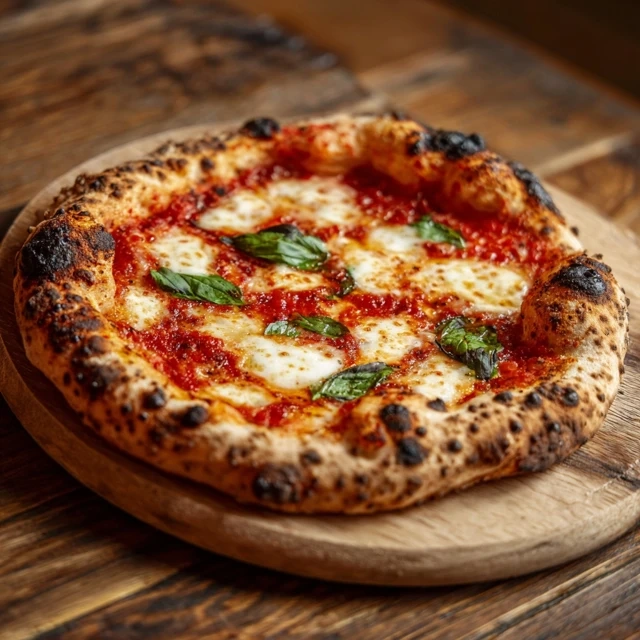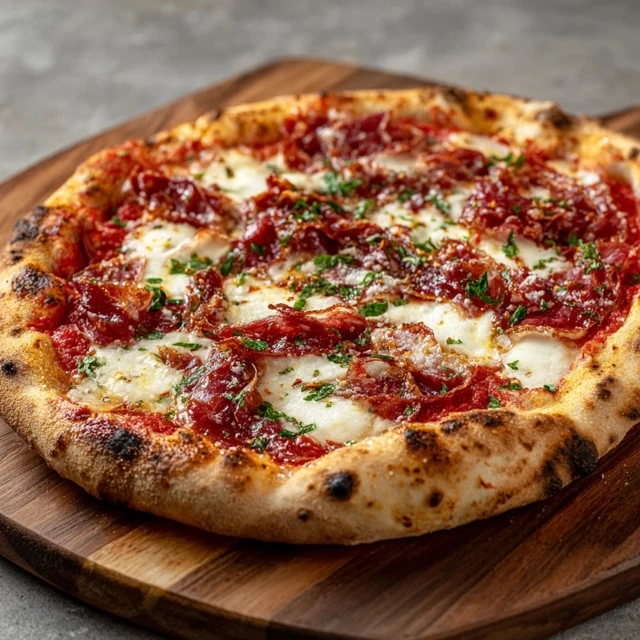The first time I saw a pizzaiolo stretch dough in Naples, I realized Neapolitan pizza is more than food. It’s an art form. Every thin, crisp crust tells a story of generations of passion, connecting you to Italy’s heart.
Neapolitan pizza is not just ingredients on bread. It’s centuries of tradition. Each part, from San Marzano tomatoes to buffalo mozzarella, speaks to Italy’s rich food heritage.
Your journey into this world will show why Neapolitan pizza is special. You’ll learn about the careful techniques that make it stand out. You’ll see how the flavors come together to make it loved worldwide.
Key Takeaways
- Neapolitan pizza represents authentic Italian culinary tradition
- Each ingredient tells a story of cultural heritage
- Traditional preparation methods are crucial to quality
- Naples remains the birthplace of true pizza craftsmanship
- Quality ingredients define the Neapolitan pizza experience
The Rich Heritage of Neapolitan Pizza Making
The Naples pizza tradition is a journey through Italian culture and history. It’s more than a meal in Naples—it’s a deep expression of cultural identity. It has won the hearts of food lovers everywhere.
Naples is where authentic pizza was born. For generations, skilled artisans have honed the art of pizza making. The city’s unique culinary scene turned simple ingredients into a global sensation.
Origins in Naples, Italy
Pizza started in Naples in the late 18th century as a food for the working class. Poor communities made this affordable, nutritious meal with tomatoes, cheese, and bread.
- Originated among working-class neighborhoods
- Created using simple, local ingredients
- Represented an economical meal solution
UNESCO Cultural Heritage Recognition
The art of Neapolitan pizza making was recognized worldwide in 2017. UNESCO named it an Intangible Cultural Heritage. This honor shows the deep cultural value of Naples pizza tradition.
Historical Evolution of Pizza Making
Pizza’s journey from a local street food to a global dish is amazing. Artisan pizzaiolos have kept traditional methods alive while introducing new ideas.
| Era | Key Development |
|---|---|
| Late 18th Century | First Street Food Emergence |
| 1889 | Creation of Margherita Pizza |
| 2017 | UNESCO Cultural Heritage Recognition |
Knowing the history of Neapolitan pizza makes each slice special. It connects you to centuries of culinary tradition.
Essential Ingredients for Authentic Neapolitan Pizza

Making an authentic Neapolitan pizza is more than just cooking. It’s about choosing top-notch ingredients. San Marzano tomatoes are at the core, adding a flavor that makes Neapolitan pizza special.
Let’s look at the key ingredients for a true Neapolitan pizza:
- San Marzano tomatoes – grown in the volcanic soil near Mount Vesuvius
- Buffalo mozzarella – creamy and rich, from specific Italian regions
- 00 flour – ultra-fine wheat flour for perfect dough
- Fresh basil leaves
- Extra virgin olive oil
The San Marzano tomatoes are key. They grow in Italy’s Campania region, in volcanic soil. Their sweet flavor and low acidity make the sauce stand out.
Buffalo mozzarella adds authenticity. Made from water buffalo milk, it has a creamy texture and rich taste. This is different from industrial cheeses.
| Ingredient | Origin | Key Characteristics |
|---|---|---|
| San Marzano Tomatoes | Campania, Italy | Sweet, low acid, bright red |
| Buffalo Mozzarella | Campania Region | Creamy, rich, distinctive flavor |
| 00 Flour | Italian Wheat Regions | Ultra-fine, perfect for thin crust |
Authentic Neapolitan pizza honors tradition and values quality. Each part is crucial for a pizza that’s more than food. It’s a work of art.
Mastering Traditional Neapolitan Dough Preparation
Making traditional Neapolitan dough is an art that needs precision, passion, and deep knowledge. The first step to making the perfect pizza is mastering the basic techniques. These techniques have been passed down through generations of Italian pizzaiolos.
Professional pizza makers know that making traditional Neapolitan dough is a challenge. It requires skill and attention to detail. Success depends on three key things: choosing the right flour, fermentation, and hand-kneading techniques.
Perfect Flour Selection
Choosing the right flour is key for traditional Neapolitan dough. Look for:
- Type 00 flour with high protein content
- Finely ground wheat flour
- Minimal processing
- Organic, stone-ground varieties
Proper Fermentation Techniques
Fermentation turns simple ingredients into a complex, flavorful base. Traditional Neapolitan dough needs patience and precise temperature control.
- Allow dough to rest at room temperature
- Use slow fermentation for enhanced flavor
- Maintain consistent humidity levels
- Monitor fermentation time carefully
Hand-Kneading Methods
Expert pizzaiolos use specific hand-kneading techniques to develop gluten and create the perfect texture. Gentle folding, rhythmic pressing, and careful stretching are key to achieving an authentic Neapolitan pizza base.
The Art of Wood-Fired Pizza Cooking
Wood-fired pizza is the top of authentic Italian cooking. It turns simple ingredients into a flavor and texture masterpiece. In a traditional pizzeria, the wood-fired oven is the kitchen’s heart, making pizzas with a unique taste.
The magic of wood-fired pizza is its intense heat and quick cooking. Traditional ovens get up to 900 degrees Fahrenheit. This heat makes the crust crispy and charred in just 60-90 seconds. It also gives the pizza a smoky flavor you can’t get with regular cooking.
- Temperatures exceed 800°F
- Cooking time under 2 minutes
- Develops distinctive smoky flavor
- Creates crispy yet tender crust
Different woods add unique flavors to your pizza. Oak gives a strong taste, while apple or cherry wood adds sweetness. Pizzaiolos pick their wood to make each pizza a special taste journey.
Wood-fired cooking is an art. It takes skill to control the fire, place the pizza right, and rotate it for even cooking. This turns simple dough and ingredients into a feast that honors Italian tradition.
Signature Styles of Neapolitan Pizza
Neapolitan pizza is a true art form with deep traditions and exciting variations. Each style has its own story of flavor, technique, and culture. It turns simple ingredients into unforgettable meals.
Pizza fans can dive into a world of Neapolitan pizza styles. These pizzas show the creativity and richness of Italian food. From timeless classics to fresh twists, there’s something for everyone.
Classic Margherita Pizza
The Margherita pizza is a symbol of Neapolitan tradition. Made in 1889 for Queen Margherita of Italy, it has:
- San Marzano tomatoes
- Fresh mozzarella cheese
- Fresh basil leaves
- Extra virgin olive oil
Marinara Variations
Marinara pizzas are a tasty, simpler choice compared to Margherita. They’re topped with tomato sauce, garlic, and oregano. These pizzas prove that less can be more.
Contemporary Interpretations
Today’s pizza makers are putting their own spin on Margherita while keeping its essence. They use:
- Artisanal ingredient combinations
- Unique regional toppings
- Experimental fermentation techniques
| Pizza Style | Key Characteristics | Origin |
|---|---|---|
| Classic Margherita | Tomato, Mozzarella, Basil | Naples, 1889 |
| Marinara | Tomato, Garlic, Oregano | Naples, Traditional |
| Modern Interpretation | Experimental Toppings | Contemporary Pizzerias |
San Marzano Tomatoes: The Secret to Perfect Sauce

San Marzano tomatoes are key to making a true Neapolitan pizza sauce. Grown in volcanic soil near Mount Vesuvius, they add a special flavor. This makes the sauce go from good to great.
So, what’s so special about San Marzano tomatoes? They stand out for several reasons:
- Sweeter and less acidic taste
- Dense, meaty texture
- Fewer seeds compared to regular tomatoes
- Rich, concentrated flavor
Choosing the right San Marzano tomatoes is important. Look for ones with the DOP (Denominazione di Origine Protetta) label. This ensures they’re from Italy. They should be bright red and have minimal processing.
To make a real pizza sauce, crush the tomatoes by hand. This keeps their flavor and texture just right. Don’t over-season – let their natural sweetness be the star.
Pro tip: For the best taste, use San Marzano tomatoes from Italy’s volcanic regions. Their unique soil gives them a flavor you can’t find anywhere else.
Buffalo Mozzarella: The Crown Jewel of Toppings
Buffalo mozzarella turns a simple pizza into a work of art. This cheese adds a creamy, rich taste that’s truly Italian. It makes every bite special with its unique flavor and soft texture.
Selecting Quality Cheese
Here’s what to look for in buffalo mozzarella:
- Bright white color with a smooth, glossy surface
- Soft, delicate texture that tears easily
- Fresh, milky aroma
- Produced in Italy’s Campania region for authenticity
Proper Storage and Usage
To keep your buffalo mozzarella fresh, follow these tips:
- Keep refrigerated at 40°F or below
- Store in its original liquid packaging
- Consume within 2-3 days of opening
- Remove from refrigerator 30 minutes before serving to enhance flavor
Regional Variations
Buffalo mozzarella varies by Italian region. Campania is the top choice, known for its high-quality cheese. Each area has its own taste and texture, showing off local dairy traditions.
Try different buffalo mozzarella types to find your favorite. This will make your Neapolitan pizza even better.
Achieving the Perfect Thin Crust
Making the perfect thin crust pizza needs skill and precision. The key to a great Neapolitan pizza is its crispy outside and soft inside. Getting this right turns a simple pizza into a work of art.
To make the perfect thin crust pizza, focus on a few important steps:
- Use high-protein flour for optimal gluten development
- Allow sufficient time for slow fermentation
- Stretch the dough by hand, avoiding rolling pins
- Maintain an extremely hot cooking surface
The dough is the first step to a great thin crust pizza. Pizzaiolos say to use 60-65% water for a light, airy crust. Gentle handling is crucial – too much handling can ruin the crust’s lightness.
Temperature is key for a perfect thin crust pizza. Wood-fired ovens at 900°F are ideal. For home cooks, use pizza stones and preheat them well.
Getting better at making thin crust pizza takes practice. Remember, a true Neapolitan pizza is simple. Few toppings let the crust’s texture be the star.
Essential Tools for Artisanal Pizza Making
Making authentic Neapolitan pizza is more than just skill and passion. It needs specialized tools to turn your kitchen into a pizza workshop. The right tools can make your pizza-making experience go from amateur to professional.
Professional pizzaiolos know each tool is key to making the perfect pizza. From precise preparation to expert cooking, here’s the essential equipment for authentic artisanal pizza making.
Pizza Peels: Your Pizza Transfer Companion
A pizza peel is more than a tool – it’s an extension of the pizzaiolo’s hand. These wooden or metal paddles help you:
- Slide pizzas into scorching hot ovens
- Rotate pizzas during cooking
- Remove pizzas safely without breaking the delicate crust
Temperature Control Tools
Precise temperature management is key in artisanal pizza making. Professional pizza makers use specific tools to monitor and control heat:
| Tool | Purpose | Temperature Range |
|---|---|---|
| Infrared Thermometer | Measure surface temperature of pizza stone | 32°F – 1,000°F |
| Oven Thermometer | Monitor oven internal temperature | 100°F – 900°F |
| Digital Probe Thermometer | Check pizza and dough temperature | 32°F – 572°F |
Dough Management Equipment
Consistent dough preparation needs specialized tools to keep quality and texture up. Professional dough management includes:
- Digital kitchen scales for precise ingredient measurements
- Dough scrapers for handling sticky dough
- Proofing containers with lids
- Dough docker to prevent excessive bubbling
Investing in these tools will turn your artisanal pizza making into a professional craft. You’ll be able to make restaurant-quality pizzas in your own kitchen.
Top Neapolitan Pizzerias in America

Finding great Neapolitan pizza in the US is now easier. Pizza lovers across the country have learned the real Neapolitan pizza making. They bring a taste of Italy to American tables.
Here are some amazing Neapolitan pizza places that truly capture the essence of this art:
- Tony’s Pizza Napoletana in San Francisco – A legendary spot where authentic Neapolitan pizza techniques shine
- Spacca Napoli in Chicago – Recognized for its commitment to traditional pizza craftsmanship
- Una Pizza Napoletana in New York City – Renowned for its precise wood-fired pizza preparation
- Pizzeria Bianco in Phoenix – Celebrated for transforming Neapolitan pizza into an art form
These pizzerias are known for following traditional Neapolitan pizza rules. They use Italian ingredients, wood-fired ovens, and old techniques. These take you straight to Naples with every bite.
Looking for real Neapolitan pizza? Look for places that:
- Use San Marzano tomatoes
- Employ buffalo mozzarella
- Bake pizzas in wood-fired ovens
- Create thin, soft crusts with crisp edges
Your trip to America’s top Neapolitan pizzerias will be a memorable food journey. It celebrates the rich tradition of Italian pizza making.
Conclusion
Neapolitan pizza is more than a meal; it’s a journey through authentic Italian cuisine. Exploring this traditional art form shows the deep cultural meaning behind each slice. From the San Marzano tomatoes to the wood-fired cooking, every element has a story.
The beauty of Neapolitan pizza is in its simplicity and quality ingredients. Whether you’re at a famous pizzeria or making it at home, you’ll see the care in every detail. This tradition is so valued that UNESCO recognized it, showing its importance in keeping Italian cuisine alive.
Now you can find real Neapolitan pizza or try making it yourself. Knowing about flour, fermentation, and wood-fire cooking makes you appreciate this dish more. Each bite connects you to Naples’ rich culinary history, offering more than just a meal.
Neapolitan pizza invites us to slow down and enjoy great food. It shows the value of tradition, passion, and quality ingredients in creating something special.

🍕 Neapolitan Pizza
Ingredients
- For the Dough:
- 3 cups 400 g 00 flour (or all-purpose flour)
- 1 teaspoon salt
- 1 teaspoon sugar
- 1 packet 2 ¼ tsp instant yeast
- 1 ¼ cups warm water 110°F / 45°C
- 2 tablespoons olive oil
- For the Sauce & Topping:
- 1 ½ cups crushed San Marzano tomatoes or good-quality canned tomatoes
- 1 tablespoon olive oil
- 1 garlic clove minced
- Salt & pepper to taste
- 8 oz 225 g fresh mozzarella, sliced
- Fresh basil leaves
- Extra olive oil for drizzling
Instructions
- Prepare the Dough: In a large bowl, mix warm water, sugar, and yeast. Let stand 5 minutes until foamy. Add flour, salt, and olive oil. Knead until smooth and elastic (8–10 minutes). Cover and let rise 2–3 hours until doubled in size.
- Make the Sauce: In a saucepan, heat olive oil over medium heat. Add garlic and cook 1 minute. Stir in tomatoes, salt, and pepper. Simmer 10 minutes, then cool.
- Assemble Pizza: Preheat oven to 500°F (260°C) with a pizza stone or baking sheet inside. Punch down dough and divide in half. Roll out each into a thin round. Spread sauce over dough, top with mozzarella slices, and add basil leaves.
- Bake: Slide pizza onto hot stone or sheet. Bake 8–10 minutes or until crust is golden and cheese is bubbling. Drizzle with olive oil before serving.
Notes
- For best results, use a pizza stone or steel to mimic wood-fired oven heat.
- Add your favorite toppings but keep it minimal for true Neapolitan style.



